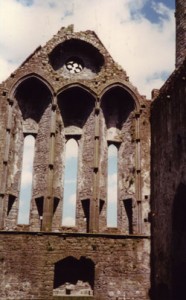Download PDF: Neville, Monastic Imagination
Medieval historian Jacques Le Goff has observed that to “study the imagination of a society is to go to the heart of its consciousness and historical evolution. It is to go to the origin and the profound nature of man, created ‘in the image of God.'”1 A lovely sentiment, to be sure, but how

might one go about the practical process of intuiting and reproducing the imaginative activities of a civilization long gone? And what purpose should such exercises serve?
In this essay, I raise the question of whether certain imaginative processes from the past might be used productively to create pedagogical strategies for the present. One of the purposes of theological education is to give future pastors, teachers, and leaders a robust sense of their Christian heritage. Imagination, I suggest, may be put to good use towards this purpose as a tool to help students enter the world of historical Christian texts. The goal must not be to entertain students merely for the purpose of enlivening the classroom experience but to invite students to venture more deeply into the cognitive realm of the historic writers themselves, or at least move them towards it. As a student of medieval historical theology, and of monastic theology in particular, I am especially interested in delving imaginatively into the historical contexts of monastic writers. If it is fruitful to help students to enter historical texts imaginatively, then perhaps first we need to have some understanding of both the theoretical and practical world of the historical practitioners themselves. I wonder, in particular, whether certain imaginative techniques employed by medieval monastic writers themselves still hold value for theology students today.
As a way to situate my questions, I present an abbreviated historical overview of the medieval understanding of imagination in the monastic context. This is to show that even as the theory of imagination changed throughout the medieval period, the imaginative practices of the monks themselves generally remained rather consistent. I then move to a pedagogical reflection that illustrates a practical method for using a kind of medieval imaginative practice in the teaching of historical texts.
Monastic Imagination: A Historical Overview
The medieval view of imagination, in the context of medieval Christian monastic writing, differed in important ways from our modern notion of the term. “Imagination” in the medieval context was neither a kind of inherent or natural creativity that could remake one’s own personal universe, nor was it equated with “fancy” or caprice, or even contrasted with these two.2 Moreover, however it was defined in different theological and monastic contexts in the Middle Ages (and its definition varied over time), imagination was not automatically assumed to be the opposite of rational or “scientific” mental activity. Indeed, this categorization of imagination, reason, and logic was not widely assumed until the advent of the “new science” in the seventeenth century.3 Rather, for the medievals (and here I am speaking very generally), imagination served two primary purposes. On the one hand, it was a tool for analyzing the exterior world and staking a claim to one’s calling within it. But on the other, it was also viewed as a mechanism for memorizing, and thus internalizing deep within the soul, the divine words of Scripture that one believed would shape one’s moral and practical participation in the communities of monastery and church.

Although it is difficult to summarize succinctly the history of imagination in Christian monastic thought prior to the Reformation, I suggest a few brief characterizations. First, no single definition of imagination holds across the broad spectrum of medieval Christian monastic thought. In certain contexts, medieval imagination was at once [pagebreaks]theoretical and practical, an essential tool in thought production; in other contexts, it represented a lower mental activity that could disrupt a concentrated contemplation of the divine. For example, in the earlier Greek sources, upon which so much of Christian contemplative theology was later based, “imagination” was perhaps best understood by the word, φαντασια (phantasia), from the verb φαινεςθαι , “to appear” (phainesthai). This term often carried a negative association of images or attachments that may distract the rational mind from its true business by placing the mind in bondage to illusions that prevent it from dealing with authentic reality. Christian theologians in this tradition, such as the late fifth-, early sixth-century “Areopagite,” the Pseudo-Dionysius, cautioned their readers along these lines, warning that too much imaginative clinging to concepts or images might tear the soul away from the heights of divine contemplation. Imagination in the early Eastern (Greek) Christian monastic context was thus not looked upon particularly favorably.
Christian thinkers in the Latin West generally used entirely different terms, inventio and imaginatio, for what we now identify as a type of imaginative thinking.4 The first term, from which we get the words “inventory” and “invention,” came directly out of the Early Imperial Roman tradition of rhetorical training,5 and connoted a process of intellectual construction that involved building a conceptual world upon the words of texts (or, in the Christian tradition, upon the words of Scripture), using in particular the functions of memory and analogy. In the Christian monastic context, inventio involved a practical process of building a communal identity upon the practice of worship and physical labor and building a harmonious body upon the order and structure of the monastic day.6 As historian Mary Carruthers masterfully demonstrates, the Christian appropriation of inventioalso required a kind of mental inventory of texts and traditions, but it additionally depended upon a creative (yet very formalized and rational) manipulation of these sources, an invention or innovation that made the religious text a metaphor for the spiritual maturation of each unique practitioner.7
The second term, imaginatio, was used in different ways throughout the medieval period, but seems more directly related to the specifically cognitive aspects of recollection and decision-making. Augustine of Hippo in particular associated imagination with memory, especially in book ten of his Confessions. Although he used the term imaginatio only on a limited basis (and seems to be one of the first Latin writers to employ this term, in addition to inventio and phantasia8), he emphasized the moral element of imagination, insofar as he connected it with the freedom of the will.9 For Augustine, the imagination mediated between the interior world of thoughts and feelings and the active operation of the will in the world.
The connection between imagination and memory continued into succeeding centuries of Latin monastic thought. Carruthers notes how the imaginative production of analogies in the medieval Cistercian study of Scripture required the practitioner to fix a biblical text in the memory by associating it analogically with something else and then re-imaging the text in new and surprising ways.10 The analogical reading of Scripture, which had become a standard of biblical interpretation since Augustine’s De Doctrina Christiana, was for Cistercians like Bernard of Clairvaux [pagebreaks]and William of St. Thierry a method for literally building an interior imaginary by meditating on and memorizing biblical texts. In his Golden Epistle, for example, William of St. Thierry urges the novice to study the exemplary behaviors from the life of Jesus and the lives of the saints as a kind of imaginative and affective contemplation that allows the practitioner to conjure images of moral rectitude, in order to stir up love for God. At this point in the twelfth century, the practice of meditatio was linked directly with imaginatio: a novice would read a story of Christ, picture it to himself by virtue of his imagination, and then use his power of imagination to place himself into that story.11
Thomas Aquinas’ theory of imagination was indebted in large part to Augustine,12 but also to the scholastic thinkers, whose work he attempted to synthesize. In particular, Thomas understood the imaginative power to function not only in the creative production of images,13 but also in the analysis of creative possibilities that the senses alone cannot perceive. For Thomas, imagination (which Thomas terms both phantasia and imaginatio) was a “storehouse” in which to incorporate and recall sense data, as part of the system that processed information; it was located in a specific part of the brain (the anterior ventricle).14 Yet it was also involved in the creation of visions, and was therefore an essential element not only in contemplation, but also in prophecy.15 This notion had been reflected almost a century earlier in the writings of Hugh of St. Victor, for whom imagination functioned as an intermediary between the rational intellect and the divine, and indeed, functioned for Hugh as one of the steps towards perfect contemplation.16 The imagination could also serve as a lens into the events of the past.17
Furthermore, and especially during the advent of high medieval “faculty psychology” in the thirteenth century, the meaning of imagination shifted to signify that inner psychological capacity that fixes itself on an object of learning, in preparation for further analytic work.18 The idea was to secure the object of learning within the mind as accurately and completely as possible – to literally create an image, or visual representation, of a text or word-picture within the recollective potential of cognitive thought. By the time of the great English intellectual Robert Grosseteste, in the late twelfth and early thirteenth centuries, imagination became a process of recollection, of literally recalling within the soul the shapes and contours of objects of learning (whether they be philosophical arguments or painted manuscript pages).19
For Grosseteste in particular, imagination was essential for discovering symbolic and theological meanings in the natural world. If the image of the Creator lay undisclosed to the immediate observation of the eye in even the smallest unit of the universe – and for Grosseteste, it did – then only the imagination could bring such evidences to light.20 Grosseteste even marked up his copy of Augustine’s De Civitate Dei with his own special symbol for “imagination” – in essence, a collection of three figure 8’s (or three “eternity” loops) intersecting at their centers.21 This symbol attests to Grosseteste’s great emphasis on imagination as the vehicle for moving the soul closer to the divine: he argued that, unless knowledge or learning about God is accompanied by an imaginative movement towards God, that knowledge is false.22
By the high medieval period, then, imagination (still known as imaginatio or, in many sources, vis imaginativa) was understood to function as a kind of ordering faculty that worked along with logic and memory not only to reproduce images and concepts, but to analyze them and use them for classifying and judging acceptable courses of action in the real world.23 Images produced through imagination were used in the formation of thoughts or ideas, either as the catalyst for igniting the process of creative cognition or for contemplative aids in the process of spiritual meditation. Some (such as Bonaventure) still remained wary of imaginatio as a power that could lead to distraction and error, and late medieval writers continued to warn of the inherent danger in relying too earnestly on images to enkindle the soul’s yearning for God (most notably, the anonymous author of the late fourteenth-century Cloud of Unknowing).24 Nevertheless, others directly drew upon the imagination in practical programs of reading and reflection, particularly those individuals devoted to the popular late medieval practice of meditating on specific episodes in the life of Christ.25 This practice involved actively imagining the feelings of biblical persons, such as Mary, Joseph, Jesus, and the Disciples, in each given textual pericope, as a way for the reader to identify emotively and personally with their sufferings and joys.
Thus, throughout the history of medieval Christian thought, imagination held a duple position. On the one hand, it was recognized as the ability to perceive, remember, and reproduce images in the mind, and thus it represented an important and necessary power of thought, and even a mechanism for recognizing not only the presence of the divine in holy Scripture, but the traces of the divine in the natural world. On the other hand, imagination was prone to error and fantasy; it could lead to day-dreaming, misunderstanding, and even a falling away from a true contemplation of God.
Despite the contested definitions and diverse historical uses of “imagination,” the second essential point to make about imagination is that of all the diverse contemplative practices within Western monastic history, practices of imagination perhaps best define the process of monastic pedagogy. The sensitive balance of devotional and practical exercises in the Benedictine monastic tradition best illustrates this point. A novice was initiated into the community through a kind of practical process of imagination, an exercise of both the creative faculty of the mind and the mnemonic capacity of the physical body. As one entered the monastic life, this creative process involved a meditative renegotiation of what it means to be a self in formation, so that as the body engaged in remembering the physical performance of worship and work, the mind engaged in remembering the words of Scripture and creatively constructing new interpretations of Scripture’s meaning.26 Central to this process was the example of the spiritual master of the community, whether that individual was the abbot or a spiritual director. By imitating the master, by literally holding in the mind the image of the abbot, or indeed, of Christ, the novice could enter the thought-world of the contemplative community and participate in its creative work.27 In entering this thought-world, it was believed, the novice could creatively encounter the divine presence in a unique, meaningful, and eminently practical way. Much of Western monastic literature was devoted to supplying the practitioner with a practical manual for how to do this work of imagination and recollection.
In the practice of lectio divina in particular, imagination was central to entering the divine life. Scholars of medieval Benedictine practice have shown that, prior to Benedict’s Rule, monks often practiced lectio divina, or the prayerful reading of holy texts (e.g., Scripture, and the Lives of the saints), in a group; Benedict’s innovation was to make this practice an individual activity.28 This reading also had a bodily dimension, inasmuch as medieval monks often read aloud, in quiet voices.29 Most important for our purposes, lectio divina involved a process of contemplation that imaginatively sought within the text a special message from God to the reader. The reading monk would focus on a specific text, and use his creative ability to tease out a meaning or a word upon which to focus his attention in prayer. Lectio divina, then, involved an imaginative exploration of words and symbols that was fundamentally practical: it was an immersion of the mind and soul in a holy text, a creative union of learning and prayer.
This process of monastic imagination was not, at any point in monastic history, a kind of static, sterile, purely mental phenomenon. Throughout the history of monastic discourse, a kind of imagination functioned as a creative dynamic that built on the existing tradition and forms of knowledge, to be sure, but simultaneously worked to lift the practitioner to the heights of contemplative union with God and ward off the depths of despair. More than serving a purely affective function, however, imagination in the monastic tradition drew upon all of the resources of the practitioner, including both the physical body and the lived experience of the actual monastic community. The goal was not to force the practitioner into a passive state of detached and thoughtless obedience to a communal regime, but rather to induce a state of creative encounter with other persons and with the living God. This process held a practical dimension; again, this was not by any means a purely intellectual exercise. Imagination involved the practice of living in community, the practice of worship, the practice of memorizing Scripture, the practice of fasting, the practice of silence, all to create a kind of cognitive break with the secular world so that the practitioner could creatively enter the divine life. The goal was actively to forget the world of the self, the selfish and egocentric concerns of flawed human existence, and to remember and imagine and participate in the self-giving love of God.
For much of the Benedictine monastic tradition, then, imagination had as much to do with memory (memoria) as with creative cognition and bodily practice.30 Even this process of memory was bodily as well as mental; the idea was that one brought one’s whole self to the work of encountering God. Each new ascetical experience provided a framework upon which to build additional experiences, not only in the mind, but also in the body. In this way, the complimentary processes of imagination and memory were the physical and mental building blocks of the religious life.
Thus, even as the actual definition of and terminology for imagination shifted across the centuries (from phantasia toimaginatio, for example), a certain kind of activity that we may broadly term “imaginative” continued to work, in the very practiceof monastic living, throughout the me dieval period. This activity was mnemonic and used in recalling the building blocks of communal life, but it was also creative, in service to the work of imaginative meditation.
Monastic Imagination: A Pedagogical Strategy

We all know that memory is an essential tool for seminary students, especially in the teaching of history. We expect students not only to understand the words of a historical text, but also to remember essential data about that text and the historical environment of its composition. Yet I want to suggest that instead of prioritizing the memorization of dates and facts and figures of history, that is, instead of prioritizing the memorization of mere content, we can encourage students to engage creatively with the texts of monastic history in an imaginative and generative way. In order to teach future pastors about the world of historical Christian practice, in order to make that study meaningful for their future pastoral work, we need to engage seminary students in a process of creative imagination. The best way to get students into the texts is to help them to enter the thought processes of the monastic writers by emphasizing an imaginative pedagogical strategy based on the very practices of the medieval monks themselves. If we can help future pastors to engage in this kind of imaginative work with historical texts, then we can perhaps introduce them to strategies for engaging creatively and practically with their future faith communities.
An imaginative investment in the text produces concrete benefits for students. First, it helps them to engage the text more deeply than they would in a quick, fact-gathering type of reading. Second, it helps them to remember important information from the text by associating that data with their own creative investigation; thus, students develop useful strategies for reading retention that are directly related to their own areas of inquiry and interest. Finally, the practice of imaginative reading effects changes within students’ minds, for it reshapes how they see and do things in the future. For example, a seminary student may choose to use monastic practices of reading in a study group in her future parish, or she may choose to use the specific process of ethical or moral textual reflection (described in the assignment below) to redefine practices of inclusivity and hospitality in congregational life.
The first section of this essay demonstrated that the theory of imagination, and even the terms used to describe it, shifted in important ways throughout the medieval period. It is therefore difficult (and probably unnecessary) to select with confidence any one imaginative theory to serve as a template for a pedagogical program for imagining specific historical contexts. However, I want to suggest that the practice of imagination in monastic communities, particularly in its pedagogical utility for novices, as described above, was generally more uniform than the diverse theories of imagination might suggest. It is this practice of imagination in the monastic context – a practice that was done in community, for the purpose of entering both the community itself and the Scriptures that bound it together – that may be employed in the modern theology or religious studies classroom.
I illustrate this point in a practical way with an assignment that I designed for a pedagogical practicum at Emory University. This assignment seeks to engage students in the task of entering the early medieval monastic world through a creative study of theRule of St. Benedict. Specifically, this offers students the opportunity to work through a practical medieval process of monastic imagination and memory, and perhaps thereby to envision the world of historical monastic practitioners differently – more imaginatively — than through a simple perusal of a monastic text. The exercise begins with a textual analysis, then moves to a creative cognitive process – the “invention” part of medieval definitions of inventio – and ends with a moral reflection on what it means to live in a religious community (a process that recalls Augustine’s take on the moral function of imagination).
These three paradigms – the textual, the inventive, and the moral – represent, in part, the practical scheme that governed much of medieval Christian biblical exegesis, inasmuch as these paradigms evoke the four-fold medieval approach to hermeneutics (i.e., the historical, the analogical, the moral, and the anagogical readings of Scripture). These techniques may also be employed today in a classroom exercise that evokes the process of medieval contemplative imagination. In particular, the late medieval practice of identifying imaginatively with the text – of placing oneself within the text, so to speak – may be used to stimulate within the student a process of identification with the reading’s historical context.
Moreover, these three paradigms also represent a practical way to teach future clergy about the resources of the Christian tradition. For the goal of the assignment is to move students from the text itself to a reflection on what it means to live in community. And this is exactly the practical purpose of monastic imagination in its broadest definition: to teach the practitioner to live in Christian harmony with self, with others, and especially with God.
The historical text becomes, then, for the student, a kind of initiation into a different way of thinking creatively about the pastoral life. By actually practicing a kind of monastic imagination, the future pastor introduces herself to a whole new resource for beginning to think about, and even to imagine in practical ways, new paradigms for contemporary Christian life.
The three approaches in the group work of the assignment (analytical, imaginative, and ethical) also serve to engage different learning styles. Some students, we may assume, will feel most comfortable making a textual analysis of the reading (e.g., Group One), as this is the approach most often enjoined in religious studies; others may feel more comfortable imagining the world of Benedict’s community (Group Two) or wondering about the implications for Benedict’s Rule in the changing life of today’s faith communities (Group Three). While students will not have the opportunity to choose their own groups, and thus most likely to select the approach most familiar to them, I have built opportunities for large group reflection into the assignment, after each small group presents to the class. In this way, students will have an opportunity to interact with their colleagues from the perspective of their own learning style. They will be stretched, perhaps, in small group work, but once the class has reassembled, they will have a chance to respond to each small group’s presentation.
CLASS ASSIGNMENT
Course Context
This assignment is prepared for the following possible contexts: a seminar on monastic theology, a seminar on medieval history, or a large introductory course on church history or historical Christianity. The class size is approximately fifteen students (either in a seminar style class format, or in a “reading section” or precept/tutorial format for a larger lecture class). This is the third or fourth class meeting, and the assigned reading is the Rule of Saint Benedict (Benedict of Nursia, ca. 480 – ca. 547). This assignment not only introduces the content of the Rule, but also suggests strategies for imaginatively engaging with historical texts. These strategies will prove fruitful over the course of the semester; the three-fold pedagogy of engagement – on analytical, imaginative, and moral levels – echoes in part the medieval schema of biblical exegesis employed by Hugh of St. Victor, among others (i.e., historical/textual, analogical, tropological/moral, and eschatological/anagogical), which are introduced later in the course. In this sense, this assignment anticipates learning objectives that will be engaged in successive learning units in the semester.
Assignment
After counting off by three’s, the class will form three small groups (Groups “One,” “Two” and “Three”). Once students have gathered in groups, they must elect one individual per group as the “time-keeper,” one individual as the “recorder,” and one individual as the “facilitator.” Students will also need to elect two individuals per group to present the small group’s work to the class. This gives a total of five roles per group; given the ideal class or precept size of fifteen students total, this means that each member of the three groups will have a specific role to fulfill in this exercise.
Each group will spend twenty to thirty minutes on the following assignments:
GROUP ONE: Analyze the theological themes in Benedict’s Rule.
How does Benedict relate his ideals for community life to the broader themes of Christian identity and doctrine? This group will carefully read through the Rule and note and record Benedict’s use of theological language. Which key theological concepts does Benedict name? What does he omit? How, for example, does Benedict describe the person of Christ, or the work of the Holy Spirit? What assumptions about God and the church does Benedict imply? Pay particular attention to the way Benedict appeals to divine authority. What are the major characteristics of the “Lord” to whom Benedict’s monks pray and after whom they model themselves?
GROUP TWO: Imagine the community that Benedict describes.
What would it be like to be part of a historical Benedictine community? The task of this group is to creatively assimilate cultural data from the Rule to envision a day in the life of Benedict’s community at Monte Cassino. Imagine that you have just begun the day with the devotion of Matins. What sounds do you hear? As you walk outside the chapel and cross the cloister, what smells do you perceive? What sights immediately assail your eyes, and what sights might be hidden behind other doors? As the day progresses, in what activities do the monks around you engage? What kind of food do you eat at the midday meal? How is silence incorporated into the rhythm of the day? Who is absent or excluded from the community, and why?
GROUP THREE: Create a “rule” for our class.
If our class were to set up our own rule for community living, what key regulations and recommendations would we need to include in order to function well together as a group? The task of this group is to thoughtfully peruse the Rule and then consider how our class might be different from Benedict’s community – and in what ways we might be similar. What imperatives might we consider keeping from Benedict’s Rule, and what might we omit? What directives might be changed in order to take seriously our own historical context and individual positionality? Why must those rules be changed in order to apply them to modern people? How should our class (assuming we were in a monastic environment together) regulate authority? What does this say about the dynamics of a modern community, as opposed to Benedict’s?
GROUP ROLES: In each group…
The TIME-KEEPER will keep the group on task and ensure that there is enough time to fulfill the assignment in full.
The FACILITATOR will make sure that every group member is allowed the opportunity to participate. Questions, reflections, and invitations to speak may assist you in this objective (“could you say more about that?”).
The RECORDER will write down each group member’s contribution without changing the content or voice of the speaker.
Two PRESENTERS will present the group’s findings to the class.
The class will reconvene in twenty to thirty minutes. After each pair of presenters shares their group work, the class will have an opportunity as a whole to reflect on the ideas that have been generated.
Through this practical exercise, I have attempted to apply a kind of practice of medieval monastic imagination to the study of a historical monastic text. This experiment relies less on any one medieval theory of imagination, and more on a general appreciation for the process of textual contemplation that was the natural mode of Benedictine communities. The goal of the exercise is not to teach students lectio divina per se; rather, I have tried to create a pedagogical experience that allows students to enter the text creatively, analytically, and ethically, as a way to introduce them to the incipient practices of reading “deeply.”
I also intend this exercise to serve as a kind of introduction to strategies for reading historical texts. Often, seminary students undertake theological education as a second career or area of expertise, having already completed degrees or cultivated vocational experience in other fields. My hope is that this exercise will allow those students in particular to reflect on what it means to encounter a historical text. Contrariwise, for students who come to class with skills already honed in historiography, I intend this exercise to awaken new avenues of inquiry. Often, the pedagogy of historical studies focuses on comparing textual sources to make inferences about a particular time or people, or to make conclusions about the developmental state of theological questions or doctrines in a specific context. Here, however, I have attempted to move students gradually into a consideration of what the texts might mean for communities now, in our contemporary world. My goal here is not to remove the historical text from its contextual situation, but rather to encourage students to wonder about what these texts might mean as the inheritance of a practical religious tradition.
Finally, it seems to me that part of the work of teaching historical theology is not only to give students a set of skills for reading texts, but also to challenge them to engage those texts in enlivening and revealing ways. One desired outcome of this exercise is the fostering of interest in the process of thinking about history. Often, students complain that historical texts are too dusty and dull to have any significance or use for “real life” today; I hope to animate a different perspective, one that finds inspiration in ancient thought-worlds and parses out new possibilities for the future. Imaginative group exercises that encourage students not only to analyze, but to dream – to critique, but also to wonder – can liberate new conclusions, new vistas, new meanings.
Featured image, “Saint Benedict” by Pietro Perugino. Public Domain.
Notes:
- Medieval historian Jacques Le Goff has observed that to “study the imagination of a society is to go to the heart of its consciousness and historical evolution. It is to go to the origin and the profound nature of man, created ‘in the image of God.'”Le Goff, Jacques. The Medieval Imagination, trans. by Arthur Goldhammer. Chicago: University of Chicago Press, 1988, p. 6.
- Here I borrow, albeit somewhat awkwardly, from the definition of Coleridge’s two levels of imagination, as presented by Garrett Green in his Imagining God: Theology and the religious imagination (San Francisco: Harper and Row, 1989), pp. 18-21.
- Green, Imagining God, p. 10.
- While this is true in a general sense, it is important to recognize that this is a gross oversimplification. Both Augustine and Aquinas, for example, used the terms phantasia and phantasma (in Augustine’s case, to signify two very different mental elements), and Aquinas used imaginatio much more often than Augustine.
- Carruthers, Mary, The Craft of Thought: Meditation, rhetoric, and the making of images, 400-1200 (Cambridge: Cambridge University Press, 1998), p. 11. This terminology, borrowed from a tradition that stretches at least as far back as Cicero, pointed, for the Roman rhetoricians, to the manipulation of the listening audience, not to the cognitive abilities of the mind: inventio was a tool of persuasion, and encompassed both the systematic discovery of topoi and the clarification of terms in service to general argument building (see, for example, George A. Kennedy’s explication ofinventio in the classical tradition in, Classical Rhetoric and its Christian and Secular Tradition from Ancient to Modern Times (Chapel Hill: University of North Carolina Press, 1999), p. 102). Inventio in its ancient pre-Christian context, then, had more of an exterior, performative focus than an interior, cerebral one. The latter context would be more representative of Christian thinkers like Augustine.
- Carruthers notes this process of cognitive “building,” p. 60.
- Carruthers, pp. 12, 20.
- Minnis, Alastair. “Medieval Imagination and Memory,” in The Cambridge History of Literary Criticism, vol. 2: The Middle Ages, ed. by Alastair Minnis and Ian Johnson (Cambridge: Cambridge University Press: 2005), p. 241. See alsoSoliloquia 2.20.24, where Augustine associates the Latin word for thinking, cogito, with the imagination, along with its memory images, phantasia and phantasma. He makes a similar correlation between cogitating and imagining in Confessions 10.1 and De vera religione20.40.
- Breyfogle, Todd, “Imagination,” in Augustine Through the Ages: an encyclopedia (gen. ed., Allan D. Fitzgerald. Grand Rapids, Mich: William B. Eerdmans, 1999), pp. 442-443.
- See, for example, Carruthers’ discussion of Bernard of Clairvaux, pp. 84-87.
- Yet William also warns that we should not read the lives of saints as a history lesson. Rather, we should constantly compare ourselves to the example of the saints, in order to create remorse for our own sins and inspire our wills to want to conform more perfectly to the will of God. By the thirteenth century, this practice of placing oneself imaginatively within the narratives of holy people was organized into a spiritual system (e.g. by Bonaventure) of imaginative exercises of the mind; this, in turn, led to the development of the imaginative Exercises of Ignatius of Loyola in the fourteenth century.
- Thomas was especially indebted to Augustine’s De Genesi ad litteram 12, as Breyfogle notes, p. 443. Generally speaking, Thomas’ account of the imagination, and its relation to the other cognitive capacities of the brain, is too complicated to be discussed in any detail here; I therefore bring to the reader’s attention only a few salient points.
- Thomas refers to the imagination as the “thesaurus” of images received through the senses – that is, a sort of catalogue and holding tank for images in the mind, to be drawn upon and used later by the memory. See, for example, Summa Theologiae 1a, q. 78, a. 4, resp (478 a). My thanks go to Dr. Philip Reynolds for pointing out this passage to me.
- In, for example, Thomas’ commentary on the Sentences of Peter Lombard: II Sent., d. 20, q. 2, a. 2, resp. (513). My thanks to Dr. Philip Reynolds for drawing this passage to my attention.
- See Thomas Aquinas’ Summa Theologiae 1.84.7, as well as 1.78.4. For Thomas, the imaginative power was useful in terms of information management, but it was not the highest mental ability involved in the process of contemplation; imagination could be prone to error (see Thomas’ Sententia super Metaphysicam. IV, lect 14, 1010b1-3, (at 693, in the edition edited by R. Cathala and R. M. Spiazzi [Turin: Marietti, 1950]). Furthermore, Thomas was the first thinker of the high medieval period to remove the distinction between phantasia and imaginatio (I am indebted to Dr. Philip Reynolds for bringing this to my attention).
- Cocking, J. M. Imagination: A Study in the History of Ideas (London: Routledge, 1991), pp. 146-148. See also Murray Wright Bundy’s concise discussion of Hugh of St. Victor’s practical use of imagination in contemplation in, “The Theory of Imagination in Classical and Mediaeval Thought,” in University of Illinois Studies in Language and Literature, vol. 12, no. 1 (February, 1927), pp. 200 – 203.
- As quoted by Minnis, p. 242. This idea was later taken up by the fourteenth-century Richard de Fournival, who noted that the imagination “makes what is past seem as if it were present.”
- R.W. Southern, Robert Grosseteste: The Growth of an English Mind in Medieval Europe (Oxford: Clarendon Press, 1986), p. 40. See also Jacqueline Hamesse, “Imaginatio et phantasia chez les auteurs philosophiques de 12e et du 13e siècle,” in M. Fattori and M. Bianchi (eds.), Phantasia-Imaginatio: VoColloquio Internazionale [del Lessico Intellettuale Europeo] Roma 9–11 gennaio 1986 (Rome: Edizioni dell’Ateneo, 1988), pp. 153–84.
- Southern, p. 42.
- Southern, p. 43.
- Bodleian MS Bodl. 198, ff. 29v, 45v, 48v, 79v, 104v, as noted in Southern, p. 43, n. 28.
- Southern, p. 45.
- See, for example, the De proprietatibus rerum of Bartholomew the Englishman, dating to before 1250, as noted by Alastair Minnis in “Medieval imagination and memory” (The Cambridge History of the Middle Ages, Vol. II, ed. by Alastair Minnis and Ian Johnson, Cambridge: Cambridge University Press, 2005, p. 239).
- Of course, a kind of imaginative work went on in the revelations and visions of late medieval visionaries; we may justifiably assume that for such visionaries as Mechthild of Magdeburg and Julian of Norwich, the imagination played an essential role in apprehending divinely-inspired messages and visions. Yet note that even for these medieval visionaries, the imagination remains an ambiguous, untrustworthy instrument, a medium in which truth is seen, but not clearly and only fleetingly.
- An example of this practice may be observed in the fourteenth-century Meditationes Vitae Christi, a popular Latin text by a Franciscan, most likely an Italian (possibly John of Caulibus). The text, which was widely read and translated in the Late Medieval period, seeks to instruct the reader in actively imagining and emotively relating to scenes from Christ’s earthly life and ministry, as a form of meditation on the Scriptures. See the translation by Francis X. Taney, Anne Miller, and C. Mary Stallings-Taney (Meditations on the Life of Christ: John of Caulibus (Asheville, NC: Pegasus Press, 1999). For another example of this type of imaginative contemplation on the life of Jesus, see the early fifteenth-century Mirror of the Blessed Life of Jesus Christ, a translation of the Meditationes by the English Carthusian Nicholas Love; a helpful starting point is Michael G. Sargent’s critical edition of the Middle English text (The Mirror of the Blessed Life of Jesus Christ: A Reading Text, ed. Michael G. Sargent, Exeter: University of Exeter Press, 2004).
- For a more complete discussion of this, please see Jean Leclerq, The Love of Learning and the Desire for God (trans. Catherine Misrahi. New York: Fordham Univ. Press, 1961). See especially pp. 15-16.
- Carruthers, pp. 21, 23.
- Kardong, Terrence G., Benedict’s Rule: A Translation and Commentary. Collegeville, Minnesota: The Liturgical Press, 1996, note 5, p. 387.
- Holzherr, Georg. The Rule of Benedict: A Guide to Christian Living: The Full Text of the Rule in Latin and English. Dublin: Four Courts Press, 1994, p. 233.
- Carruthers, p. 23.






